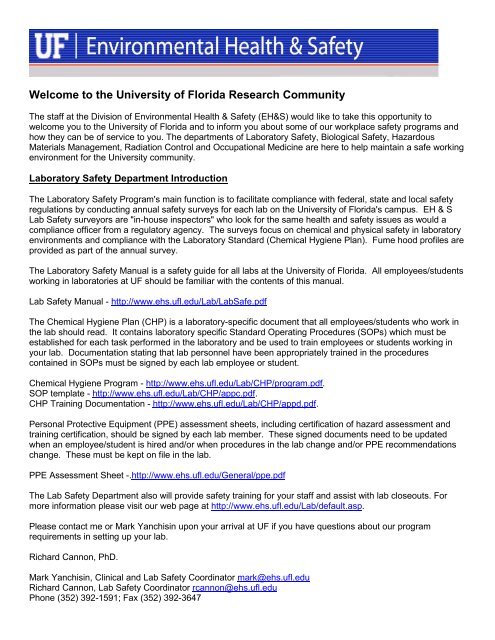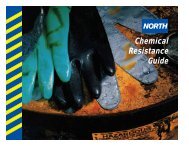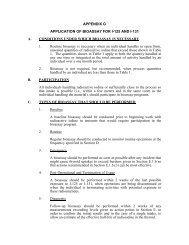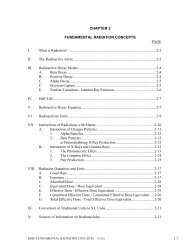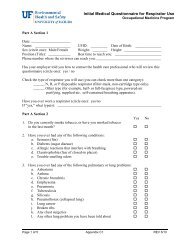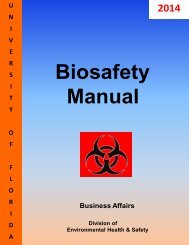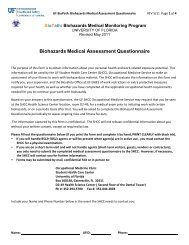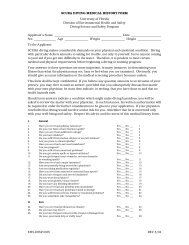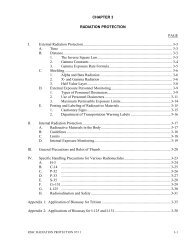Welcome to Your New Lab at UF - University of Florida
Welcome to Your New Lab at UF - University of Florida
Welcome to Your New Lab at UF - University of Florida
Create successful ePaper yourself
Turn your PDF publications into a flip-book with our unique Google optimized e-Paper software.
<strong>Welcome</strong> <strong>to</strong> the <strong>University</strong> <strong>of</strong> <strong>Florida</strong> Research Community<br />
The staff <strong>at</strong> the Division <strong>of</strong> Environmental Health & Safety (EH&S) would like <strong>to</strong> take this opportunity <strong>to</strong><br />
welcome you <strong>to</strong> the <strong>University</strong> <strong>of</strong> <strong>Florida</strong> and <strong>to</strong> inform you about some <strong>of</strong> our workplace safety programs and<br />
how they can be <strong>of</strong> service <strong>to</strong> you. The departments <strong>of</strong> <strong>Lab</strong>ora<strong>to</strong>ry Safety, Biological Safety, Hazardous<br />
M<strong>at</strong>erials Management, Radi<strong>at</strong>ion Control and Occup<strong>at</strong>ional Medicine are here <strong>to</strong> help maintain a safe working<br />
environment for the <strong>University</strong> community.<br />
<strong>Lab</strong>ora<strong>to</strong>ry Safety Department Introduction<br />
The <strong>Lab</strong>ora<strong>to</strong>ry Safety Program's main function is <strong>to</strong> facilit<strong>at</strong>e compliance with federal, st<strong>at</strong>e and local safety<br />
regul<strong>at</strong>ions by conducting annual safety surveys for each lab on the <strong>University</strong> <strong>of</strong> <strong>Florida</strong>'s campus. EH & S<br />
<strong>Lab</strong> Safety surveyors are "in-house inspec<strong>to</strong>rs" who look for the same health and safety issues as would a<br />
compliance <strong>of</strong>ficer from a regula<strong>to</strong>ry agency. The surveys focus on chemical and physical safety in labora<strong>to</strong>ry<br />
environments and compliance with the <strong>Lab</strong>ora<strong>to</strong>ry Standard (Chemical Hygiene Plan). Fume hood pr<strong>of</strong>iles are<br />
provided as part <strong>of</strong> the annual survey.<br />
The <strong>Lab</strong>ora<strong>to</strong>ry Safety Manual is a safety guide for all labs <strong>at</strong> the <strong>University</strong> <strong>of</strong> <strong>Florida</strong>. All employees/students<br />
working in labora<strong>to</strong>ries <strong>at</strong> <strong>UF</strong> should be familiar with the contents <strong>of</strong> this manual.<br />
<strong>Lab</strong> Safety Manual - http://www.ehs.ufl.edu/<strong>Lab</strong>/<strong>Lab</strong>Safe.pdf<br />
The Chemical Hygiene Plan (CHP) is a labora<strong>to</strong>ry-specific document th<strong>at</strong> all employees/students who work in<br />
the lab should read. It contains labora<strong>to</strong>ry specific Standard Oper<strong>at</strong>ing Procedures (SOPs) which must be<br />
established for each task performed in the labora<strong>to</strong>ry and be used <strong>to</strong> train employees or students working in<br />
your lab. Document<strong>at</strong>ion st<strong>at</strong>ing th<strong>at</strong> lab personnel have been appropri<strong>at</strong>ely trained in the procedures<br />
contained in SOPs must be signed by each lab employee or student.<br />
Chemical Hygiene Program - http://www.ehs.ufl.edu/<strong>Lab</strong>/CHP/program.pdf.<br />
SOP templ<strong>at</strong>e - http://www.ehs.ufl.edu/<strong>Lab</strong>/CHP/appc.pdf.<br />
CHP Training Document<strong>at</strong>ion - http://www.ehs.ufl.edu/<strong>Lab</strong>/CHP/appd.pdf.<br />
Personal Protective Equipment (PPE) assessment sheets, including certific<strong>at</strong>ion <strong>of</strong> hazard assessment and<br />
training certific<strong>at</strong>ion, should be signed by each lab member. These signed documents need <strong>to</strong> be upd<strong>at</strong>ed<br />
when an employee/student is hired and/or when procedures in the lab change and/or PPE recommend<strong>at</strong>ions<br />
change. These must be kept on file in the lab.<br />
PPE Assessment Sheet -.http://www.ehs.ufl.edu/General/ppe.pdf<br />
The <strong>Lab</strong> Safety Department also will provide safety training for your staff and assist with lab closeouts. For<br />
more inform<strong>at</strong>ion please visit our web page <strong>at</strong> http://www.ehs.ufl.edu/<strong>Lab</strong>/default.asp.<br />
Please contact me or Mark Yanchisin upon your arrival <strong>at</strong> <strong>UF</strong> if you have questions about our program<br />
requirements in setting up your lab.<br />
Richard Cannon, PhD.<br />
Mark Yanchisin, Clinical and <strong>Lab</strong> Safety Coordina<strong>to</strong>r mark@ehs.ufl.edu<br />
Richard Cannon, <strong>Lab</strong> Safety Coordina<strong>to</strong>r rcannon@ehs.ufl.edu<br />
Phone (352) 392-1591; Fax (352) 392-3647
Biological Safety Program Introduction<br />
The Biological Safety Office is responsible for ensuring institutional compliance with federal and st<strong>at</strong>e biological<br />
research regul<strong>at</strong>ions, including the safe s<strong>to</strong>rage, handling, and disposal <strong>of</strong> all biological agents. To th<strong>at</strong> end,<br />
the Biological Safety Office provides inform<strong>at</strong>ion, training, and oversight <strong>to</strong> the <strong>UF</strong> life science research, health<br />
care, agricultural, & biotechnology communities. The following is an overview <strong>of</strong> our key functions and policies.<br />
More details can be found on our website http://www.ehs.ufl.edu/Bio/default.asp and in our biosafety manual<br />
http://www.ehs.ufl.edu/Bio/BioMan.pdf.<br />
Select Agent program: Special registr<strong>at</strong>ion is needed before working with select agents; see<br />
http://www.ehs.ufl.edu/Bio/select.htm. Researchers considering work with any <strong>of</strong> these m<strong>at</strong>erials must first<br />
contact the Biological Safety Office <strong>at</strong> 392-1591 <strong>to</strong> initi<strong>at</strong>e the registr<strong>at</strong>ion process or <strong>to</strong> see if federal<br />
registr<strong>at</strong>ion exemptions or exclusions may apply.<br />
Project Registr<strong>at</strong>ion: A biohazard risk assessment and registr<strong>at</strong>ion form is required for projects using<br />
p<strong>at</strong>hogens, recombinant DNA, or acute <strong>to</strong>xins. Registr<strong>at</strong>ion documents (found on our website) are reviewed by<br />
the Biosafety Office staff and the Institutional Biosafety Committee. A project approval or exemption letter<br />
outlining the appropri<strong>at</strong>e containment and safety practices for the work will be issued along with a registr<strong>at</strong>ion<br />
number. Non-exempt projects are upd<strong>at</strong>ed annually, but projects may be modified <strong>at</strong> any time by way <strong>of</strong> a<br />
project addendum.<br />
Permits: Federal or st<strong>at</strong>e permits may be required for some biological m<strong>at</strong>erials. Contact us <strong>at</strong> 392-1591 for<br />
more inform<strong>at</strong>ion. Permits are issued in the name <strong>of</strong> the PI who is required <strong>to</strong> keep them upd<strong>at</strong>ed and current<br />
as necessary; the Biosafety Office does not hold any “centralized” permits.<br />
Animal Contact Program: Particip<strong>at</strong>ion is required for faculty, staff, students, volunteers, or visi<strong>to</strong>rs who have<br />
direct exposure <strong>to</strong> vertebr<strong>at</strong>e animals, animal m<strong>at</strong>erial, and/or those who enter <strong>UF</strong> animal facilities. The<br />
program consists <strong>of</strong> medical moni<strong>to</strong>ring and educ<strong>at</strong>ional components. Participants complete a Risk<br />
Assessment form th<strong>at</strong> will be evalu<strong>at</strong>ed by <strong>UF</strong>’s Occup<strong>at</strong>ional Medicine Program <strong>to</strong> assess potential health<br />
risks from the animal project and determine whether additional inform<strong>at</strong>ion and/or interaction is necessary.<br />
Medical Moni<strong>to</strong>ring Program: Enrollment in <strong>UF</strong>’s Occup<strong>at</strong>ional Medicine Program <strong>at</strong> the <strong>UF</strong> Student Health<br />
Care Center is required for people working with the following: all BSL3 agents, tuberculosis, Orthopox viruses,<br />
HIV, Hep<strong>at</strong>itis, Influenza, Arboviruses, and certain Zoonotics (e.g., Q fever, Monkey B virus, etc.). Please<br />
contact our <strong>of</strong>fice <strong>at</strong> 392-1591 for more inform<strong>at</strong>ion.<br />
<strong>UF</strong> Minors Policy: Registr<strong>at</strong>ion and parental consent is required for non-<strong>UF</strong> students under 18 years <strong>of</strong> age<br />
intending <strong>to</strong> work or research in labora<strong>to</strong>ries, greenhouses, and animal facilities (science fair projects,<br />
volunteering, internships, etc). Registr<strong>at</strong>ion forms can be obtained from http://www.ehs.ufl.edu/Bio/minors.htm.<br />
Training programs: Please call our <strong>of</strong>fice <strong>at</strong> 392-1591, or visit our website for schedules, details, or questions.<br />
• Bloodborne P<strong>at</strong>hogen training: required for all personnel having potential exposure <strong>to</strong> human blood or<br />
any other potentially infectious body fluids, unfixed tissue, primary human cells and tissue cultures.<br />
Annual refresher training is required.<br />
• Shipping and Transport <strong>of</strong> Biohazardous M<strong>at</strong>erial training: required for all individuals involved in the<br />
prepar<strong>at</strong>ion or transport <strong>of</strong> dangerous goods per IATA/ICAO and DOT regul<strong>at</strong>ions. Training needs <strong>to</strong><br />
be renewed every 2 years. Many biological m<strong>at</strong>erials fall in<strong>to</strong> the c<strong>at</strong>egory <strong>of</strong> “dangerous goods” for<br />
shipping purposes. In addition, we require safe transport <strong>of</strong> items within facilities and around campus -<br />
also covered in the training.<br />
• Biomedical/Biological Waste Handling is covered in the Bloodborne P<strong>at</strong>hogen training session or<br />
classes are available on request.<br />
• Safe use <strong>of</strong> au<strong>to</strong>clave classes are available by request.
Au<strong>to</strong>claves: Most au<strong>to</strong>claves are required <strong>to</strong> be tested for effective oper<strong>at</strong>ion every 40 hours <strong>of</strong> use.<br />
Au<strong>to</strong>claves <strong>at</strong> Health Science Center facilities are tested by the Biosafety Office. Au<strong>to</strong>claves th<strong>at</strong> are not part<br />
<strong>of</strong> this program will require th<strong>at</strong> the Biosafety Office approve oper<strong>at</strong>ional and testing procedures.<br />
Biosafety Surveys/Audits: Biosafety surveys/audits (inspections) are conducted in labora<strong>to</strong>ries, green<br />
houses and animal facilities on a periodic basis. We will also conduct an audit <strong>of</strong> newly established labs <strong>to</strong> help<br />
PIs set up a safe and compliant research environment. These surveys identify potential hazards and facilit<strong>at</strong>e<br />
compliance with safety policies and regul<strong>at</strong>ions relevant <strong>to</strong> the use <strong>of</strong> biological m<strong>at</strong>erials <strong>at</strong> <strong>UF</strong> (e.g. NIH,<br />
CDC, USDA, OSHA, and the <strong>Florida</strong> Dept. <strong>of</strong> Health regul<strong>at</strong>ions).<br />
Biosafety Cabinets: A biosafety cabinet (BSC) is an important containment device th<strong>at</strong> may be required<br />
depending on the n<strong>at</strong>ure <strong>of</strong> your work. Class II (Types A and B) biological safety cabinets are most commonly<br />
used for personnel protection, product protection, and environmental protection.<br />
• The cabinet will need <strong>to</strong> be certified (according <strong>to</strong> a N<strong>at</strong>ional Sanit<strong>at</strong>ion Found<strong>at</strong>ion standard) when set<br />
up and annually thereafter if it is used for work with infectious m<strong>at</strong>erial. Please contact the EH&S<br />
Biological Safety Office for the name and phone number <strong>of</strong> the current contrac<strong>to</strong>r performing this<br />
service.<br />
• Ultraviolet Lamps are not recommended; they loose antimicrobial activity quickly and are a hazard <strong>to</strong><br />
exposed skin, eyes, and equipment.<br />
• Bunson Burners/Alcohol lamps are not permitted in a biological safety cabinet. Their use cre<strong>at</strong>es<br />
turbulence th<strong>at</strong> disrupts the p<strong>at</strong>tern <strong>of</strong> air supplied <strong>to</strong> the work surface, damages paper HEPA filters,<br />
and any leaking gas re-circul<strong>at</strong>es, building <strong>to</strong> potentially explosive levels.<br />
How <strong>to</strong> Find Us!<br />
• Karen Gillis Biological Safety Officer. (kgillis@ehs.ufl.edu)<br />
• Bhavna Bhardwaj Associ<strong>at</strong>e Biological Safety Officers. (bhardwaj@ehs.ufl.edu)<br />
• Sharon Judge, Biological Safety Coordina<strong>to</strong>r (sjudge@ehs.ufl.edu)<br />
• Telephone: (352) 392-1591<br />
• Fax: (352) 392-3647<br />
Hazardous M<strong>at</strong>erial Management Program Introduction<br />
The Hazardous M<strong>at</strong>erials Management (HMM) program provides three primary services <strong>to</strong> the <strong>University</strong><br />
Community: (1) Collection and Disposal <strong>of</strong> Hazardous Chemicals and Radioactive Waste; (2) Training <strong>of</strong> staff<br />
in safe and correct handling <strong>of</strong> hazardous chemical waste and radioactive wastes; and (3) Emergency<br />
response in the event <strong>of</strong> a Hazardous Chemical Spill. Radioactive M<strong>at</strong>erial spills are the responsibility <strong>of</strong> the<br />
Radi<strong>at</strong>ion Control Office.<br />
The <strong>University</strong> <strong>of</strong> <strong>Florida</strong> has a zero discharge policy with regard <strong>to</strong> hazardous m<strong>at</strong>erial. No hazardous<br />
m<strong>at</strong>erials are allowed <strong>to</strong> be placed in sink drains. Each investiga<strong>to</strong>r or shop will gener<strong>at</strong>e waste following the<br />
S<strong>at</strong>ellite Area Accumul<strong>at</strong>ion (SAA) requirements as defined by EPA and found in summary <strong>at</strong><br />
http://www.ehs.ufl.edu/HMM/SAAREQS.htm. Procedures and techniques <strong>to</strong> be used for chemical waste<br />
accumul<strong>at</strong>ion within the s<strong>at</strong>ellite area are found in http://www.ehs.ufl.edu/HMM/HWMG0207.pdf. Procedures<br />
for radioactive waste accumul<strong>at</strong>ion are found in http://www.ehs.ufl.edu/Rad/RCGuide/rcg2.htm#2XII.<br />
Waste must be accumul<strong>at</strong>ed <strong>at</strong> or near the point <strong>of</strong> gener<strong>at</strong>ion and under the direct supervision <strong>of</strong> the PI or lab<br />
(shop) manager. Waste is collected by HMM <strong>at</strong> th<strong>at</strong> loc<strong>at</strong>ion. Chemical waste pickup forms are submitted<br />
electronically and by mail for radioactive waste. Chemical waste pickup forms are available <strong>at</strong><br />
http://www.ehs.ufl.edu/HMM/Pickups/default.asp. Radioactive waste forms are available by contacting the<br />
HMM department <strong>at</strong> (352) 392-8400. <strong>Lab</strong>els and some containers for chemical and radioactive wastes are<br />
also provided.
It is the responsibility <strong>of</strong> the PI <strong>to</strong> insure th<strong>at</strong> the SAA, chemical wastes, and radioactive wastes are properly<br />
managed. Failure <strong>to</strong> follow established policy may result in waste not being collected, higher disposal costs or<br />
fines from regula<strong>to</strong>ry agencies.<br />
All staff gener<strong>at</strong>ing and managing hazardous waste must complete EPA required training (provided by HMM)<br />
within 6 months <strong>of</strong> beginning work with hazardous m<strong>at</strong>erials. The lab manager should be trained annually<br />
thereafter. Contact HMM <strong>at</strong> (352) 392-8400 <strong>to</strong> sign up for a class.<br />
HMM also provides recycling opportunities for lamps, b<strong>at</strong>teries, etc. Methods for collection <strong>of</strong> this m<strong>at</strong>erial vary<br />
with campus loc<strong>at</strong>ion.<br />
Contact: Bill Coughlin <strong>at</strong> (352) 392-8400 for additional inform<strong>at</strong>ion<br />
Radi<strong>at</strong>ion Control and Radi<strong>at</strong>ion Services Department Introduction<br />
The Radi<strong>at</strong>ion Control and Radiological Services Department is dedic<strong>at</strong>ed <strong>to</strong> facilit<strong>at</strong>ing research <strong>at</strong> <strong>UF</strong> through<br />
a comprehensive radi<strong>at</strong>ion safety program which promotes the health and safety <strong>of</strong> students, staff and visi<strong>to</strong>rs.<br />
The Radi<strong>at</strong>ion Control Office assists the <strong>University</strong> community by providing consult<strong>at</strong>ions, evalu<strong>at</strong>ions and<br />
inspections which reduce or elimin<strong>at</strong>e conditions which may lead <strong>to</strong> injury or loss <strong>of</strong> <strong>University</strong> resources.<br />
Any use <strong>of</strong> radioactive m<strong>at</strong>erial as part <strong>of</strong> your research must be approved by the Radi<strong>at</strong>ion Control Committee<br />
prior <strong>to</strong> receiving, s<strong>to</strong>ring or using the radioactive m<strong>at</strong>erial. All personnel who will be working with radioactive<br />
m<strong>at</strong>erials must be trained in the use <strong>of</strong> radioactive m<strong>at</strong>erials and have document<strong>at</strong>ion <strong>of</strong> th<strong>at</strong> training. Radi<strong>at</strong>ion<br />
training is provided by our staff on a regular basis.<br />
Any research requiring the use <strong>of</strong> X-ray equipment must be approved by the Radi<strong>at</strong>ion Control Office. The<br />
required inform<strong>at</strong>ion for these requests can be found <strong>at</strong> the Environmental Health and Safety web site under<br />
the Radi<strong>at</strong>ion Control section. If you bring any x-ray equipment with you, the equipment must be registered<br />
with the Radi<strong>at</strong>ion Control Office. http://www.ehs.ufl.edu/Rad/RCGuide/devices.htm<br />
All class 3b and 4 lasers and laser systems used <strong>at</strong> the <strong>University</strong> must be registered with the Department <strong>of</strong><br />
Radi<strong>at</strong>ion Control and Radiological Services. The users <strong>of</strong> these lasers must also be registered. The<br />
registr<strong>at</strong>ion forms for the lasers and laser users can be found <strong>at</strong> the Environmental Health and Safety web site<br />
under the Radi<strong>at</strong>ion Control section. http://www.ehs.ufl.edu/Rad/laser/default.asp<br />
For further inform<strong>at</strong>ion concerning the <strong>University</strong> <strong>of</strong> <strong>Florida</strong> Radi<strong>at</strong>ion Control Program, you can download our<br />
Program Guide which is found <strong>at</strong> http://www.ehs.ufl.edu/Rad/default.asp.<br />
Contact Inform<strong>at</strong>ion:<br />
Main Campus: Donald Munroe: Radi<strong>at</strong>ion Control Officer/Assistant Direc<strong>to</strong>r EH&S don@ehs.ufl.edu<br />
Telephone: (352) 392-7359<br />
Fax: (352) 846-0489<br />
Health Science Center: Dee Pringle, Assistant Radi<strong>at</strong>ion Control Officer (dbpringle@ehs.ufl.edu)<br />
Telephone: (352) 392-1589<br />
Fax: (352) 846-1626<br />
Occup<strong>at</strong>ional Medicine Program Introduction<br />
The <strong>University</strong> <strong>of</strong> <strong>Florida</strong>’s Occup<strong>at</strong>ional Medicine Program (OCCMED) is one <strong>of</strong> many programs established<br />
by Environmental Health and Safety <strong>to</strong> promote a safe and healthy environment in which all members <strong>of</strong> the
university community can excel in educ<strong>at</strong>ion, research and service. Based on specific job duties with<br />
associ<strong>at</strong>ed known health risks, the OCCMED Program provides preplacement health assessments before an<br />
individual begins the work assignment. Some <strong>of</strong> these job duties also trigger periodic medical moni<strong>to</strong>ring<br />
throughout the assignment with <strong>UF</strong>. Those individuals covered by the Program include faculty, staff, students,<br />
volunteers and visi<strong>to</strong>rs.<br />
The Program is managed by EH&S along with <strong>UF</strong>’s Student Health Care Center (SHCC). EH&S coordin<strong>at</strong>es<br />
the Program. The SHCC provides health assessments and oversees the employee immuniz<strong>at</strong>ion program. All<br />
medical records are kept <strong>at</strong> the SHCC and tre<strong>at</strong>ed as confidential according <strong>to</strong> federal HIPAA laws and <strong>Florida</strong><br />
st<strong>at</strong>utes.<br />
Job duties th<strong>at</strong> trigger a health assessment are documented in PeopleS<strong>of</strong>t’s position inform<strong>at</strong>ion for individuals<br />
assigned <strong>to</strong> a position. For those who are not assigned <strong>to</strong> a position (such as OPS, research assistants, post<br />
docs), the form Individuals Not on a Position should be used<br />
(http://www.ehs.ufl.edu/formium/server.asp?form=INOPOn.pdf). All job duties th<strong>at</strong> require a health<br />
assessment <strong>at</strong> <strong>UF</strong> are listed <strong>at</strong> http://www.ehs.ufl.edu/OCCMED/jobduty.pdf.<br />
Three areas <strong>of</strong>ten seen in faculty assignments are animal contact, contact with human blood and p<strong>at</strong>ient<br />
contact. Another frequent area for research is respira<strong>to</strong>r use - both tight-fitting canister type and N95.<br />
• <strong>UF</strong>’s Animal Contact Program is described in this document’s Biological Safety Program<br />
Introduction. For more details on animal contact please go <strong>to</strong><br />
http://www.ehs.ufl.edu/Bio/Animal/acweb.htm.<br />
• <strong>UF</strong>’s Bloodborne P<strong>at</strong>hogen Program is also noted in the Biological Safety section. For more details<br />
on contact with human blood or other potentially infectious m<strong>at</strong>erials, please see<br />
http://www.ehs.ufl.edu/Bio/BBP/default.htm.<br />
• The SHCC’s OCCMED Policy and Procedure document <strong>at</strong><br />
http://www.shcc.ufl.edu/occmed/pdf/policy.pdf outlines requirements for p<strong>at</strong>ient contact as well as all<br />
the included job duties.<br />
• <strong>UF</strong>’s Respira<strong>to</strong>ry Protection Program strives <strong>to</strong> prevent adverse health affects from the inhal<strong>at</strong>ion <strong>of</strong><br />
hazardous airborne contaminants. Individuals required <strong>to</strong> wear a tight-fitting canister type respira<strong>to</strong>r or<br />
an N95 must first be medically cleared by the SHCC and then trained and fit tested by EH&S. Annual<br />
training and fit testing is required for all. Details <strong>of</strong> this program are documented <strong>at</strong><br />
http://www.ehs.ufl.edu/General/resppol.pdf.<br />
Also included in the OCCMED program are those working in areas <strong>of</strong> excessive noise, the handling <strong>of</strong><br />
pesticides and scientific research diving. All these and more are included in this program. Full<br />
Program descriptions and a list <strong>of</strong> forms can be found <strong>at</strong> http://www.ehs.ufl.edu/OCCMED/default.asp.<br />
Occup<strong>at</strong>ional Medicine Program Contact Inform<strong>at</strong>ion:<br />
Grace Dixon, Occup<strong>at</strong>ional Medicine Program Coordina<strong>to</strong>r (gldixon@ehs.ufl.edu)<br />
Telephone: (352) 392-1591<br />
Fax: (352) 392-3414<br />
Questions regarding the OCCMED health screening process, please call the Student Health Care Center <strong>at</strong><br />
(352) 392-0627.


